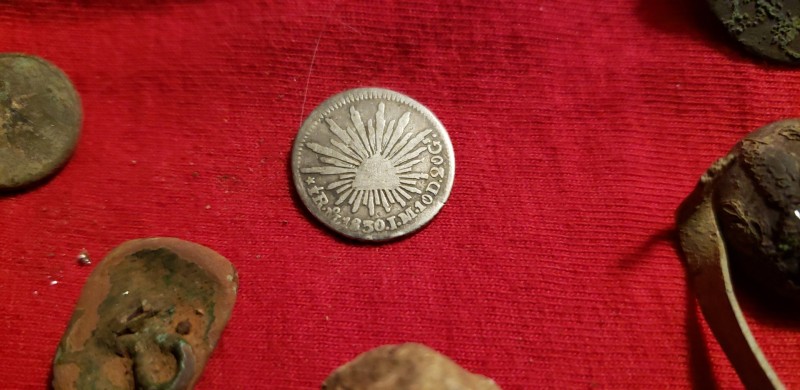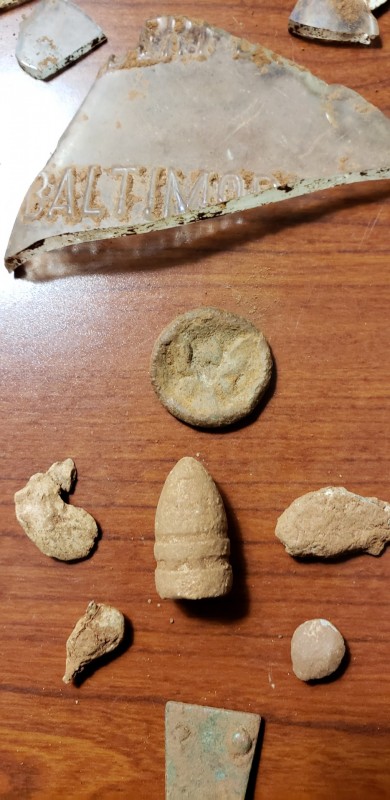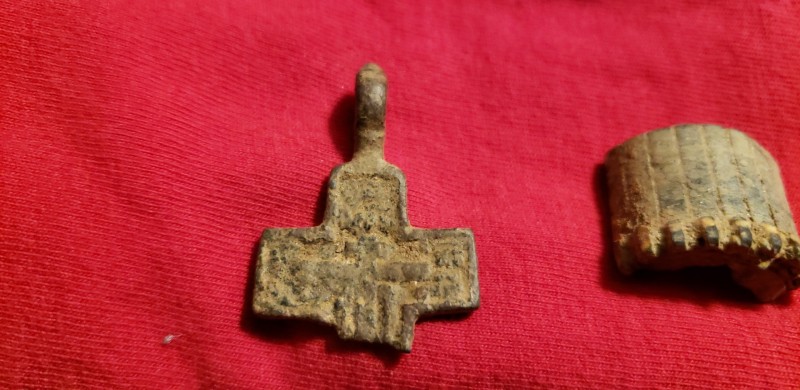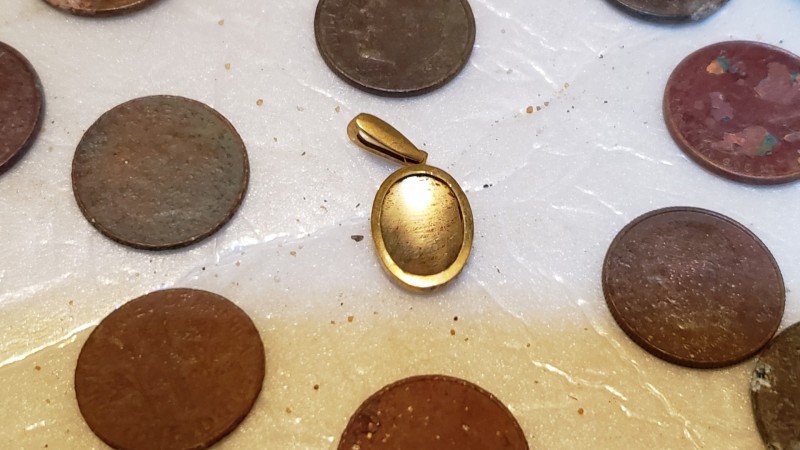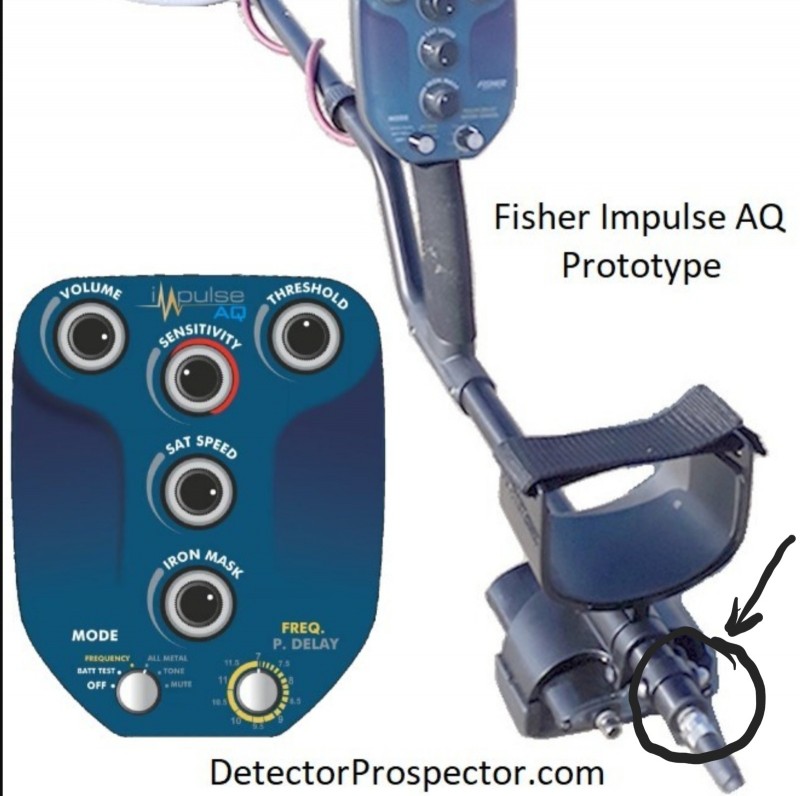-
Posts
6,131 -
Joined
-
Last visited
Content Type
Forums
Detector Prospector Home
Detector Database
Downloads
Everything posted by Chase Goldman
-

Have You Paid For Your Detector?
Chase Goldman replied to mn90403's topic in Detector Prospector Forum
For me the value of detecting is more about the activity than the finds. The hobby pays for itself in fun, solitude (de-stress), amazing scenery and sights, the exercise, and enjoying outings and discussing all things detecting with friends. Most of my most prized finds have little to no intrinsic or collectable value. Paying for the detector with finds is not something that is even remotely part of my detecting equation because that is more like work, which is the exact opposite of why I detect. I don't begrudge folks who measure their success with with how many buckets they fill with gold, jewelry, coins, and relics. But even if I were successful enough (and had the opportunity to spend all my spare time detecting) to consistently recover valuable finds, I still wouldn't be paying for my detectors because I have never sold a single find other than recycling some clad through coinstar, much to the consternation of my wife. So, I guess with respect to the "have you paid for your detector?" metric, I'm a failure as a detectorist. -
First up was a CW period US Cavalry bit boss found at the site of the largest Cavalry engagement of the Civil War - The Battle of Brandy Station (GPX 4800) The next is an 1830 Mexican First Republic Half Reale (XP Orx) The third is a purposefully flattened Eagle Coat button used either as a checker piece or Poker chip (Equinox got me into the fire pit where it was buried a along with some other relics including a lead backing to a cartridge box plate, a sword hanger piece, minie ball, and broken glass and dishware). Honorable mentions... A gold locket found at the beach in the dead of winter and an antique cross pendant
- 21 replies
-
- gold found
- jewelry found
-
(and 1 more)
Tagged with:
-
Rick - you killed it with that write up. Excellent info. Bookmarking that post for future reference. Thanks so much. Enjoy putting it through its paces. Looking forward to your additional reports. So I see that being able to master the sweet spot between ATS, the Reject breakpoint setting, and pulse delay for the target(s) of interest will be the skill that determines your level of success (unless you just want to go max depth and Dig it All in AM (though ferrous may still give you a telltale double tone)).
-

Vanquish 340 Preliminary Review
Chase Goldman replied to Jeff McClendon's topic in Minelab Metal Detectors
I believe this too. To maintain depth, they are probably not dialing back transmit power on the Vanquish like they do in Beach mode on the Equinox. This may keep it from being as stable as Equinox on salt beaches with black sand. But makes it a decent all around detector, especially on high conductors. -

Vanquish 340 Preliminary Review
Chase Goldman replied to Jeff McClendon's topic in Minelab Metal Detectors
Jeff - Why not Park 1 on the Equinox which more of a high conductive coin mode and might be more comparative of the Vanquish coin mode? Park 2 is optimized for mid-conductors which would tend to better illuminate the aluminum junk. Also, since the 340 has high iron bias on by default, yet you set F2=1 on the Eq, not surprising those crown caps sounded off. Thanks for running the side-by-side, good info. -

Vanquish 340 Preliminary Review
Chase Goldman replied to Jeff McClendon's topic in Minelab Metal Detectors
Agree, especially since the coil is only compatible with Vanquish, not sure you could even unload the coil. It doesn’t make sense for 340/440 users to get one who have the 10” coil, so that just leaves 540 non-pro pack buyers who made the conscious decision not to get the coil in the first place so your target market segment is almost non-existent. You’d be better off not getting the pro pack. -
Probably a railroad police badge for the Virginia and Tennessee railroad which existed with that name between the 1850’s through approximately 1870 when it then became part of the M, N, & O railroad group and eventually became Norfolk and Western and then Norfolk Southern. Which means this badge probably pre-dates 1870. Cool find.
-

Vanquish 340 Preliminary Review
Chase Goldman replied to Jeff McClendon's topic in Minelab Metal Detectors
Why are you selling the 8” coil? -

Vanquish 340 Preliminary Review
Chase Goldman replied to Jeff McClendon's topic in Minelab Metal Detectors
True - note that even with all metal (no discrimination) selected - iron bias will still affect the target signal regardless, but it will be a stronger iron signal with less falsing if it is on "high". Note also on the Equinox - "0" iron bias does not mean "No" iron bias. "0" is just the minimum setting for whichever iron bias filter you are using (FE or F2) but there is still some bias filtering taking place even at "0" setting and "0" FE does not equal "0" F2. -

Second Seminole Indian War Finds
Chase Goldman replied to ColonelDan's topic in Metal Detecting For Coins & Relics
Incredible finds, Dan. Both in terms of what they are and the condition they are in. Great job by you and your team. -

Minelab GPX 4500 Discontinued
Chase Goldman replied to shredmandan's topic in Minelab Metal Detectors
At the Diggin' in Virginia hunts Debbie S. from ML is usually in attendance and they raffle off a ML donated GPX. This last time around in November, they made it a point to mention that this would be the last GPX 4500 raffled off at DIV as the model was discontnued. I guess it will be a 5000 next time and the raffle chance ticket prices will also likely go up. -
The following is a discussion of existing PI detector features that I find to be useful for relic hunting that goes beyond the target discrimination break-point discussion that Steve articulated so well above. Beside the high mass-high conductor/low mass-low conductor discrimination breakpoint setting - another useful feature implemented in the ML GPX and to a lesser extent (or less successfully, based on my experience) on the Garrett ATX is iron identification, rejection, or blanking. The GPX implements a blanking function on probable "high" (low tone) corroded iron signals with the peak of the signal tone blanking out. Not 100% effective as it can also provide "false positives" on non-ferrous targets but it is nevertheless a pretty useful feature. Similarly, the ATX has an iron grunt check, which is both ergonomically inferior (requires you to engage a separate button during your swing) and I have found it to be less reliable (almost to the point that it is a 50/50 proposition if you do get an iron grunt). Blanking has it's drawbacks of course. Besides reliability, iron reject/blanking on the ML can only be utilized with DD coils and can become overwhelmed in thick iron situations. Anyway, Alexandre or Rick (once you get your machine), if either of you can shed light on whether such a feature will exist on any or all iterations of the Fisher Impulse, that would be enlightening. Finally, compared to the Garret ATX, I find that the as you gain experience digging innumerable nails, the tone "shape" of the GPX provides a wealth of information. For example, the classic "W" double peak high tone (low conductor/small mass target) is often a clue that you are swinging along the long axis of a nail. Turn 90 degrees and that nail sounds like a sweet high tone indicative of round brass or small lead. Bent nails, however, are very difficult to ID, they sound great. Higher mass minie balls give a nice smooth low tone that will not break unlike a large rusted nail or other piece of iron. The ATX uses more of a processed doorbell high-low/low-high tone, so it cannot convey much additional target information other than the high conductor/high mass or opposite characterization. So I am interested whether the tone implementation on the Fisher Impulse target audio will convey analog-signal-like target characterization (e.g., irregular or regular shape) information. Thanks for reading. Excited to see the Fisher Impulse in action.
-
The Pulse Dive is a solid product. I bought one but then traded it to a friend for a coil (he will put the Pulse Dive to better use in Florida), while I opted for just the wireless pinpointer version sans the dive coil attachment (about $50 less) as a companion for my Simplex since it pairs with the Simplex wireless headphones.
-
BTW Erik, your statement above is the reason Steve went down the path of trying to explain to you what pulse induction technology is and why it doesn't necessarily work well for finding small gold in salt water environs. So be careful as you are tending to contradict yourself in your own thread with statements like... This is fairly common technology that is also used in terrestrial pinpointers. There are several different PI dive detectors using similar technology and vibration modes on the market from Quest (the Scuba-Tector), from Nokta (The Pulse Dive), and of course the Vibratector Steve linked previously. The old addage, you get what you pay for usually applies. Their detection range is rather limited. Good luck.
-

Could Not Make Eqx To See The Target
Chase Goldman replied to nordic's topic in Minelab Equinox Forum
Thanks for the detailed reply, it gives a better perspective on how you have been approaching your testing. -
I recommend the upgrade, but perhaps you should wait to see what other folks opinions are on version 2.0. I have a primary and backup 800 since one gets abused beach hunting. I had 1.5 on one and 1.75 on the other. Once 2.0 came out with the F2 filter, I went ahead and upgraded both to 2.0. I felt 1.7.5 caused the 6-inch coil to false a little more on iron. F2 adjustments addressed that concern. The good news is that you can easily move between all three firmware versions so there is no situation where you can't go back to a version you like if the new one does not float your boat. Check out this thread - the OP is not a fan of 2.0 and has tried out all three versions and is deciding between 1.5 and 1.7.5. So you can read through his experience in the field and in his home testing to get his perspective on the various versions.
-

The Wm08 Module Vs The Wireless Headphones
Chase Goldman replied to RobNC's topic in Minelab Equinox Forum
Some claim to be able to tell the difference, but anything less than 50 ms is generally imperceptible to most people. The problem I have found with the WM08 module is that it is a little finicky about placement. It wants to have a clear line of site to the control head to prevent dropouts. Some folks attach it to their hat to accomplish this or use a very short run of cable between the headphones and the module (the Gray Ghost NDT's are ideal for this because they have removable headphone cords and you can order a short (<1ft) Mini-XLR to mini-plug patch cable and attach the WM08 to the headphones themselves to give them clear line of site to the control head. The ML headphone adapter + regular length Gray Ghost headphone cable means you have to stuff all that cable somewhere even if you plan to wear the WM08 on your waist so it is a doable but a little unwieldy. When it is all said and done, the WM08 makes a great backup solution if your BT headphones take a dump, but the BT headphones perform just fine as far as latency is concerned IMO (you would have noticed it already if it was going to really bother you - really only comes into play when moving the coil for target wiggle off pinpointing or locking in a signal amongst the trash). The only way I would switch over to WM08 is if I felt the GG audio (or the audio from whatever wired phones I was using) was noticeably superior to the included BT phones - and some do feel the BT phone audio falls short. I don't fall into that camp. I also have hooked up a BT transmitter to my GPX so I can use the same BT APTX LL headphones for either my Equinox or my GPX. HTH -
I haven't really noticed a change in ID - nevertheless if you are just starting over with the Equinox, that shouldn't be a factor for you. F2 is an added option that I like and since ML retained FE, then you don't even have to revert the firmware to stick with FE. So basically, I see no reason not to upgrade. That being said, are you certain you used the proper key sequence to get you to the F2 option and it was not there? Specifically, once you navigate to the iron bias settings menu you need to press the accept/reject button to toggle between FE/F2. Pardon the question, but it is just a tad tricky to get there so just wanted to be sure. Apologies if you already did this as state and were not able to pull up F2.
-

Could Not Make Eqx To See The Target
Chase Goldman replied to nordic's topic in Minelab Equinox Forum
Really interested in how you are able to make these firmware comparison determinations in the field by running a single firmware version at a time. Are you switching firmware versions in the field or just going by "memory" or feel from the last time out? What is the control you are using to make determinations like the recovery speed assertion? This is a very difficult thing to do when you have two detectors loaded up side by side with different firmwares, so I am impressed with your ability to do that over a period of days. It is not possible for most but having two detectors out there at a time to do some real firmware side-by-side comparisons in the field would be ideal. Applaud your determination and detailed feedback, nevertheless. So do we have a winner on the firmware wars, then (I know that 2.0 seems to be the loser as far as you are concerned based on your reporting so far)? Oh and it would also be helpful to compare the settings (sensitivity, Deus operating frequency, Equinox mode, recovery speed settings for each detector, etc.) between the Equinox and Deus and also the types of targets (high or low conductors) that were unable to be seen by Deus that were picked up by the Equinox, if possible. I have both the Equinox and the Deus and am constantly vacillating back and forth between these detectors on what I decide to go with on a given outing - if there is thick iron, the Deus usually wins out (I guess that is telling me there is minimal difference in performance overall). Thanks. -
Thanks, Rick. Would give you a reaction like on your previous post but I hit my daily quota limit Can't wait to see what your early production model looks like vs. the posted prototype pics. One thing of interest is whether that headphone jack is still embedded in the armrest stem tube and a detaiked explanation of the settings/controls.



